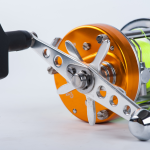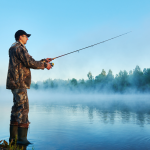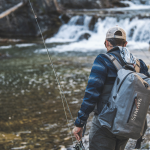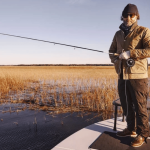As an angler, if you are looking for a challenge and some great-tasting fish, then catfish should be your go-to option. Known for being both delicious and difficult to catch, catfish can make for some great fishing trips. However, all this is possible only if you know how to catch catfish.
For every angler, fishing for catfish is an exciting and rewarding endeavor. It is a great way to spend the day, get outdoors and cast your line in search of the perfect catch. The problem is there is more to it than just casting your line. You need the right tools and knowledge for success.
That is why in the following guide, I will provide you with the most effective ways and methods of catching catfish. Reading this article will give you all the information necessary for angling some truly impressive catches on your next fishing expedition.
From choosing the right bait to setting up the hook, I will cover everything you need to know to have an enjoyable and fruitful outing. So let’s get started.
Catfishing Locations and Seasons
The locations and seasons for catfishing vary depending on the type of catfish being targeted, as well as the region. Different types of catfish can be found in different areas, with some species requiring specific seasons and conditions to thrive.
Knowing where to look and when to cast your line can help you maximize your chances of success. With this in mind, it is important to understand the different locations and seasons that are ideal for catfishing to have the best possible experience.
If you are fishing during the day with complete sunshine, the best place to look for catfish is in water full of mud. Also, mention small and deep holes, extensive structures, lakes, steep river bends etc. are some of the possibilities for finding catfish.
While the night is suited for better fishing. With excellent sense and smell, it is easy for catfish to find food. Hence, more chances of catching all sizes of catfish.
Important Catfish Equipment
Though it is not a difficult process to catch catfish, still you need all the basic tools. Whether you are a beginner or an experienced angler, having quality catfish equipment can make your fishing trips much more enjoyable. The following are the essential items needed for catfishing.
- Rod
- Reel
- Tackle boxes
- Bait
- Lures
- Hooks
- Net for fish landing
How to Catch Catfish by Hand?
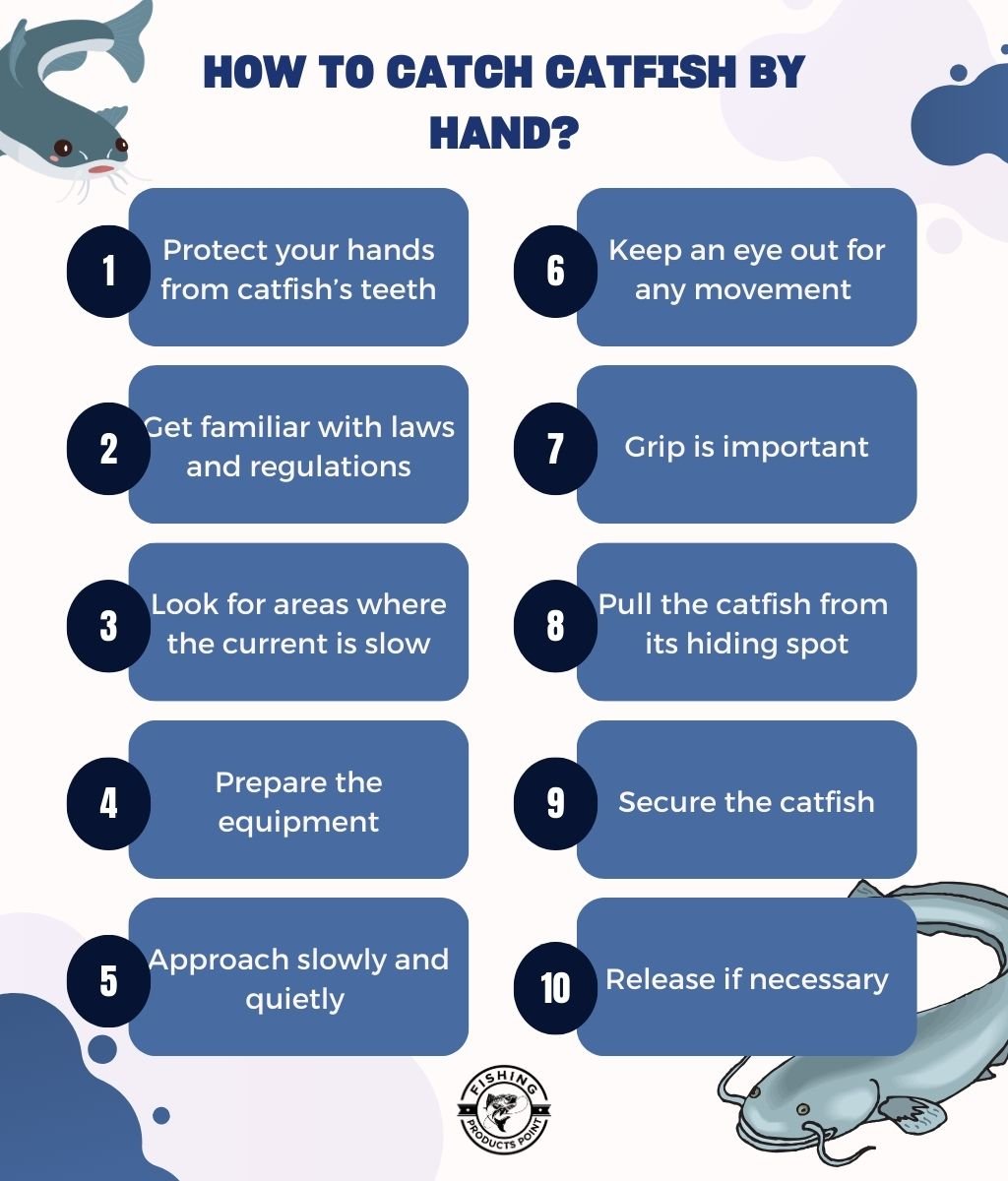
Several methods can be used in learning how to catch catfish. It all depends on the type of catfish you plan to catch. Hand-catching a catfish also known as noodling or hand-fishing is one of the most popular methods. It allows you to get up close and personal with your target fish.
Here is some expert advice and assistance on how to catch catfish by hand:
- Safety first
Always bring a partner with you when noodling, as water conditions and obstacles can be unpredictable. Wear gloves to protect your hands from sharp objects or the catfish’s teeth, and wear non-slip water shoes for better grip on slippery surfaces.
- Know the Rules
Familiarize yourself with local laws and regulations regarding noodling, as it is illegal or restricted in some areas.
- Locate potential spots
Catfish often hide in underwater holes and crevices during the daytime. Look for areas where the current is slow, such as near fallen trees, banks, or submerged rock formations.
- Prepare your equipment
Bring a sturdy rope or cord to secure yourself to an object in case of strong currents. A mesh bag or metal stringer will also be useful for holding the caught catfish.
- Approach cautiously
Make sure to move slowly and quietly when approaching a potential hiding spot, so as not to scare away the catfish.
- Check for catfish
Submerge your hands into the hole or crevice and feel around for the presence of a catfish. Pay attention to any movement or tail brushing against your fingers.
- Secure your grip
Once you have located a catfish, attempt to securely grip its lower jaw with one hand while supporting its body weight with the other hand.
- Carefully remove from the hiding spot
Gently but firmly pull the catfish from its hiding spot, keeping a firm grip on its jaw at all times.
- Secure your catch
Place the caught catfish inside your mesh bag or attach it to your metal stringer.
- Release if necessary
If required by local laws or if you are practicing catch and release, return the catfish to the water safely.
How to Catch Catfish in Lakes?
To catch catfish in lakes, follow these expert tips and steps:
- Gear up
Equip yourself with the right fishing gear – a medium to heavy action rod, a spinning or baitcasting reel, and a 15-30 pound monofilament or braided line.
- Choose the right bait:
Catfish prefer natural food like cut bait (cut-up fish), shrimp, worms, chicken liver, and live baitfish. Experiment with different options to see what works best in your area.
- Know the best time:
Catfish are more active during early mornings, late evenings, and at night. This is when they feed most actively, increasing your chances of catching them.
- Find the right spot:
Look for areas with structures such as fallen trees, rocks, or docks where catfish hide during the day. Additionally, seek out deeper holes in the lake bed or areas where shallow waters transition to deeper ones.
- Use the right rig:
A Carolina rig or slip-sinker rig works well for fishing for catfish in lakes. This type of rig allows the bait’s scent to disperse throughout the water while keeping it close to structures and the lake bottom.
- Cast your line:
Cast your baited hook into your chosen location and allow it to sink to the bottom.
- Wait patiently
Once your line is cast, keep your rod steady and watch your line closely for any strikes or nibbles from a hungry catfish.
- Set the hook
When you detect a bite, give your rod a firm jerk to set the hook in the catfish’s mouth.
- Reel it in
Keep even pressure on the fish as you reel it in slowly but steadily. Make sure to hold onto your rod firmly and be prepared for any sudden movements by the fish trying to swim away.
- Land the fish
Once you bring the catfish close enough to land or boat, use a net or fish grips to secure it. Be cautious when handling catfish, as they have sharp spines on their dorsal and pectoral fins.
- Safely release or keep
If you plan to release the fish, remove the hook gently and return it to the water. If you choose to keep your catch, follow appropriate legal guidelines and store it in a cooler with ice.
How to catch catfish in a pond?

To catch catfish in a pond, follow these steps:
- Choose the right time
Catfish are most active during the early morning and late evening hours. These are the best times for fishing to increase your chances of success.
- Select appropriate bait
Catfish enjoy a variety of bait such as live bait, cut bait, and stink bait. Live baits like worms, minnows, and crawfish are very effective. Cut bait made from fish as shad or herring works well too.
- Use suitable gear
Use a medium-heavy to heavy action rod around 7-9 feet in length with a strong spinning or baitcasting reel. Choose a line with at least 15-20 lb test strength.
- Rig your line
Two popular catfish rigs are the slip-sinker rig and the float rig. For the slip-sinker rig, thread an egg sinker onto the line, followed by a bead and then tie on a barrel swivel.
Attach an 8-12 inch leader with a circle or treble hook to the other side of the barrel swivel. For the float rig, first, tie on the hook, then attach a bobber or float at the desired depth above it.
- Choose your location
Look for areas near structures like submerged logs, rocks, or vegetation where catfish might hide. Also, consider deeper areas with access to shallow feeding grounds.
- Cast your line
Cast your baited rig into your chosen area and wait for any bites.
- Detect catfish bites
Watch for subtle movement in the line or changes in tension. Catfish can bite gently, so pay close attention.
- Set the hook
When you’re sure you have a catfish on your line, reel in any slack line and set the hook with a quick upward motion of the rod.
- Reel in the catfish
Keep steady pressure on the line while reeling in the fish, avoiding any slack. If the catfish is large and puts up a fight, carefully play it out before reeling it in.
- Safely handle the catfish
Use a landing net or grab the fish carefully behind its head, avoiding the sharp spines on the dorsal and pectoral fins.
- Release or keep the catfish:
If you choose to release the catfish, gently place it back in the water. If you want to keep it, be sure to check local regulations about size and catch limits before doing so.
How to catch catfish at night?
To learn how to catch catfish at night, follow these expert tips and techniques:
- Choose the right location
Look for areas where catfish are likely to be feeding, such as near structures, drop-offs, or current breaks in rivers and lakes. In addition, catfish are often more active in shallow water during nighttime hours.
- Use appropriate bait
Catfish have a keen sense of smell, so using stinky bait like chicken liver, shad, nightcrawlers or prepared baits can help attract them. Experiment with different types of bait to see what works best in your fishing spot.
- Select suitable gear
Use medium-heavy to heavy-action rods with a strong backbone and enough sensitivity to detect subtle bites. Spinning or baitcasting reels with a minimum of 12-20 lb monofilament or braided line are recommended for night fishing.
- Rig your line effectively
Popular rigs for catching catfish include the Carolina rig, slip sinker rig and three-way swivel rig. Add a small float or slip bobber above the hook to prevent the bait from sinking too far into the mud or weeds.
- Illuminate your area
Aid visibility by using a lantern, headlamp, or boat lights. Be cautious not to use excessive light as it can deter fish from approaching your bait.
- Patience is key
Catfish tend to be more cautious at night and may take longer to commit to biting your bait. Wait for a definitive bite before setting the hook – yanking too soon can lead to missed opportunities.
- Safety precautions
When fishing at night, bring proper safety equipment, such as a life jacket and first aid kit if needed. Inform someone about your whereabouts and expected return time as a precautionary measure.
Conclusion
Catching catfish requires a combination of proper planning, equipment, and techniques. To increase your chances of success, use the right bait, choose an ideal location, employ effective fishing techniques, and always pay attention to local regulations.
In this article, I have explained how to catch catfish through several different methods. By following these steps and honing your skills through experience, you will be well on your way to becoming an expert catfish angler. Happy hunting!

